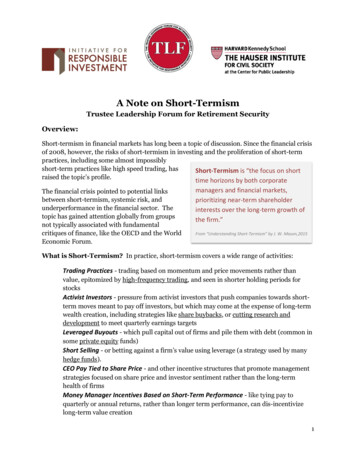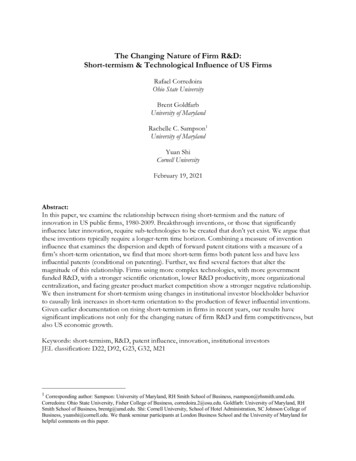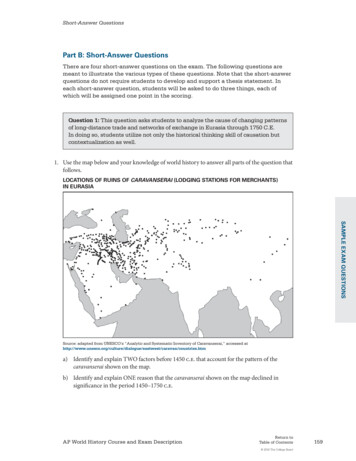
Transcription
A Note on Short-TermismTrustee Leadership Forum for Retirement SecurityOverview:Short-termism in financial markets has long been a topic of discussion. Since the financial crisisof 2008, however, the risks of short-termism in investing and the proliferation of short-termpractices, including some almost impossiblyshort-term practices like high speed trading, hasShort-Termism is “the focus on shortraised the topic’s profile.The financial crisis pointed to potential linksbetween short-termism, systemic risk, andunderperformance in the financial sector. Thetopic has gained attention globally from groupsnot typically associated with fundamentalcritiques of finance, like the OECD and the WorldEconomic Forum.time horizons by both corporatemanagers and financial markets,prioritizing near-term shareholderinterests over the long-term growth ofthe firm.”From “Understanding Short-Termism” by J. W. Mason,2015What is Short-Termism? In practice, short-termism covers a wide range of activities:Trading Practices - trading based on momentum and price movements rather thanvalue, epitomized by high-frequency trading, and seen in shorter holding periods forstocksActivist Investors - pressure from activist investors that push companies towards shortterm moves meant to pay off investors, but which may come at the expense of long-termwealth creation, including strategies like share buybacks, or cutting research anddevelopment to meet quarterly earnings targetsLeveraged Buyouts - which pull capital out of firms and pile them with debt (common insome private equity funds)Short Selling - or betting against a firm’s value using leverage (a strategy used by manyhedge funds).CEO Pay Tied to Share Price - and other incentive structures that promote managementstrategies focused on share price and investor sentiment rather than the long-termhealth of firmsMoney Manager Incentives Based on Short-Term Performance - like tying pay toquarterly or annual returns, rather than longer term performance, can dis-incentivizelong-term value creation1
These short-term investing strategies offer immediate rewards, but may have consequences forthe long-term. Seeking immediate high returns without accounting for long-term implicationsmay lead to underperformance for longterm investors, and, by extension,Long-Term Investing requires patient,underperformance for the economy as awhole.engaged, and productive capital:Short-termism can seem like a riddle:those investors with the most weight inthe market are thought to be large assetowners with long-term time horizons,but it is their investment strategies thatpromote short-termism in the market.In theory, large asset owners like pensionfunds have the potential to guide thefinancial system back in the direction oflong-term investing and away fromshort-term expectations which are, eventoday, increasingly driving the market.(World Economic Forum, 2011) Inpractice, they often help create theproblem by rewarding managers andcompanies for short-term behavior.“Patient capital allows investors to accessilliquidity premia, lowers turnover, encouragesless pro-cyclical investment strategies andtherefore higher net investment rate of returnsand greater financial stability.“Engaged capital encourages active votingpolicies, leading to better corporategovernance.“Productive capital supports infrastructuredevelopment . . . leading to sustainablegrowth.”From OECD Project on Institutional Investors and Long-Term Investment(Della Corce, Stewart, & and Yermo, 2011)What Kind of Risk Might Short-Termism Pose?Short-termism, with its disproportionate focus on quarterly returns, may be weakening firmsand the economy as short-term investment strategies leave companies with less to invest inresearch and development and growth. (Mason, 2015) With so much focus on near-termreturns, firms are doing less planning for future success, and are less willing to take on projectsthat may require multiple years - and patient capital - to develop. (The Conference Board, 2015)(Barton, Focusing Capital on the Long Term, 2014) Instead of productive investment in the realeconomy, short-termism may promote bubbles, financial instability and general economicunderperformance by incentivizing activity which benefits the few while providing little value tosociety.Short-term financial strategies may also have the effect of taking capital out of the productiveeconomy, increasing the holdings of high-net worth individuals, and adding to the growth ofincome inequality. (Stiglitz, ReWriting the Rules of the American Economy, 2015)2
Barriers for Pension Funds to Long-Term InvestmentInstitutional investors, including pension funds, face real, though not insurmountable, barrierswhen considering long-term investing. Considering potential barriers may be helpful to trusteesas they endeavor to move their fund further in the direction of long-term investing.Liability Profile – the degree to which the fund must service short-term obligations, suchas upcoming payments to beneficiaries (World Economic Forum, 2011)Funding Regulations – timelines and penalties imposed by regulatorsHerding – benchmarking against others’ performance and the tendency of investors tomove together in their investment strategyDecision-Making/Governance Structure – the ability of the investment team andtrustees to execute a long-term investment strategy (World Economic Forum, 2011)Investment Beliefs – whether the institution believes long-term investing can producesuperior returns (World Economic Forum, 2011)What Can Trustees Do?At pension funds, especially defined benefit funds with fixed liabilities, short-termism can bedriven heavily by regulatory requirements around funding status. Funding regulations andliability constraints are very real issues for pension trustees. Despite these constraints, there area number of concrete ways that pension funds may work to move their funds towards a longerview of investing. Pension trustees may want to examine their fund’s governance structure andinvestment beliefs to understand where long-termism can be fostered. Trustees may also wantto support investor mandates through active engagement with firms or directives to moneymanagers, and the integration of environmental, social and governance factors into theinvestment decision making process to support a long-term investment strategy.Short-Termism and Investment StrategyGovernance – Examining how fund governance is structured, and whether it supports longterm investing can be useful. Trustees may want to look at how decision making around longtermism is made at their fund, and how trustees fit into that structure. Identifying where withinthe governance structure questions of short- and long-term investing are discussed and decided,3
and engaging that structure, is important formaking change. Trustees can generatediscussion around questions like:“How do benchmarks for relativeperformance incentivize (or disincentive)long-termism?”“Are money manager incentives promotingshort-term gains or long-term valuecreation?”“To what extent is our fund’s investingstrategy incenting the use of short-termstrategies, like high-frequency trading,leveraged buy-outs, short-selling, or sharebuybacks?”“How are we engaging as active ownerswith firms to encourage long-terminvestment decisions?”Investment Beliefs – Pension trustees canlook to their funds’ investment beliefsstatement (or move to create one) for theirfund to gain clarity about workingassumptions on long-term investing.“Investment Belief Statements areimportant”, says Steve Lydenberg, FoundingDirector of the Initiative for ResponsibleInvestment, “because they help trustees,fiduciaries, and others responsible clarifytheir views on the nature of financialmarkets through which they must operateand how these markets function.”(Lydenberg, 2011) CalPERS’ investmentbelief statement #2 (see side bar) is a goodexample of how funds can integrate longtermism into an investment belief statement.CalPERS Investment Beliefs Statement #2A long time investment horizon is aresponsibility and an advantage.Long time horizon requires that CalPERS:A. Consider the impact of its actions onfuture generations of members andtaxpayers.B. Encourage investee companies andexternal managers to consider the longterm impact of their actions.C. Favor investment strategies that createlong-term, sustainable value andrecognize the critical importance of astrong and durable economy in theattainment of funding objectives.D. Advocate for public policies thatpromote fair, orderly and effectivelyregulated capital markets.Long time horizon enables CalPERS to:A. Invest in illiquid assets, provided anappropriate premium is earned forilliquidity risk.B. Invest in opportunistic strategies,providing liquidity when the market isshort of it.C. Take advantage of factors thatmaterialize slowly such as demographictrends.D. Tolerate some volatility in asset valuesand returns, as long as sufficientliquidity is available.CalPERS Investment Beliefs Statement4
Every investment decision CalPERS makes is informed by its ten investment beliefs, includingthe funds’ decision in the fall of 2014 to exit hedge funds.Investor Mandates – Engagement with firms and active ownership can be used to communicatean investors’ preference for long-term investment strategies. Asset owners can provideinvestment professionals with a clear mandate to place value on long-termism “. . . rather thanto compete in horse races judged on short-term performance”. Investors can “demand longterm metrics from companies” (Barton, Focusing Capital on the Long Term, 2014), discouragestock buybacks, use “Say on Pay” votes to discourage outsized CEO compensation, or look atwhether incentives are tied to short-term or long-term outcomes.Integrating Environmental, Social and Governance (ESG) Factors – Investors with a SociallyResponsible Investment (SRI) approach, tend to have less portfolio turnover (Santisteve, 2014).SRI investors integrate consideration of issues like the quality of jobs, environmental impacts,how firms are run, and the impact of investment on the world into their investment process.Short-Termism and Systemic ChangeTo the extent allowable, pension funds and trustees may want to encourage change at a levelbeyond their fund to support long-term investment. This could include:SEC Changes-place direct limits on buybacksincrease reporting requirements for buybacksinstitute a proxy access rule that incentivizes long-term investmentLegislative Changes-create a financial transaction tax which discourages high frequency tradingremove tax incentives that encourage firms to reward CEOs through incentive based paylimit private equity’s use of leverage and dividend recapitalizationfocus economic policy on the real economy – ie, jobs and infrastructureMany of these ideas are explored in the report “Ending Short-Termism: An Agenda for Growth”by Mike Konczal for The Roosevelt Institute.ConclusionShort-termism and the risks it poses, both at a portfolio level and to the wider economy, hasgained increased global attention in recent years as these strategies have proliferated. Pensionfunds are large, influential investors, making trustees potential leaders in moving the economytowards more long-term investing and away from volatile short-term investing practices.5
ReferencesBarton, D. a. (2013). Focusing Capital on the Long Term. McKinsey & Company.Barton, D. a. (2014). Focusing Capital on the Long Term. Harvard Business Review.Cremers, M., Pareek, A., & and Sautner, Z. (2016). Short-Term Investors, Long-TermInvestments, and Firm Value.Della Corce, R., Stewart, F., & and Yermo, J. (2011). Promoting Longer-Term Investment byInstitutional Investors: Selecte Issues and Policies. OECD Journal: Fiancial MarketTrends.Konczal, M., Mason, J. W., & and Page-Hoongrajok, A. (2015). Ending Short-Termism.Roosevelt Institute.Lydenberg, S. (2011). Investment Beliefs Statements.Mason, J. W. (2015). Understanding Short-Termism: Questions and Consequences.Organisation for Economic Co-operation and Development. (2014). Institutional Investors andLong-term Investing.Santisteve, M. (2014, August 4). Long-Term Investing is Gaining Momentum. CNBC.Stiglitz, J. E. (2015, December 10). How to Fix Inequality. The Boston Globe.Stiglitz, J. E. (2015). ReWriting the Rules of the American Economy. W. W. Norton & Company.The Conference Board. (2015). Is Short-Term Behavior Jeopardizing the Future Prosperity ofBusiness.White, G. B. (2015, November 2). Stiglitz: Here's How to Fix Inequality. The Atlantic.World Economic Forum. (2011). The Future of Long-term Investing.6
of 2008, however, the risks of short-termism in investing and the proliferation of short-term practices, including some almost impossibly short-term practices like high speed trading, has raised the topic’s profile. The financial crisis pointed to potential links between short-termism, sys










